Effects of Interface Trap on Transient Negative Capacitance Effect: Phase Field Model
Abstract
1. Introduction
2. Simulation
3. Results and Discussion
4. Conclusions
Author Contributions
Funding
Conflicts of Interest
References
- Moore, G. Cramming More Components onto Integrated Circuits. Proc. IEEE 1998, 86, 82–85. [Google Scholar] [CrossRef]
- Lee, C.; Ko, E.; Shin, C. Steep Slope Silicon-On-Insulator Feedback Field-Effect Transistor: Design and Performance Analysis. IEEE Trans. Electron Devices 2018, 66, 286–291. [Google Scholar] [CrossRef]
- Park, J.; Shin, C. Tunnel Field-Effect Transistor with Segmented Channel. IEEE J. Electron Devices Soc. 2019, 7, 621–625. [Google Scholar] [CrossRef]
- Ko, E.; Shin, J.; Shin, C. Steep switching devices for low power applications: Negative differential capacitance/resistance field effect transistors. Nano Converg. 2018, 5, 1–9. [Google Scholar] [CrossRef] [PubMed]
- Cho, K.; Shin, C. Simulation Techniques for Nanoelectromechanical (NEM) Relay. J. Nanosci. Nanotechnol. 2018, 18, 6615–6618. [Google Scholar] [CrossRef] [PubMed]
- Ko, E.; Shin, J.; Shin, C. Steep Slope Silicon-on-Insulator Field Effect Transistor with Negative Capacitance: Analysis on Hysteresis. J. Nanosci. Nanotechnol. 2019, 19, 6128–6130. [Google Scholar] [CrossRef] [PubMed]
- Salahuddin, S.; Datta, S. Use of Negative Capacitance to Provide Voltage Amplification for Low Power Nanoscale Devices. Nano Lett. 2008, 8, 405–410. [Google Scholar] [CrossRef]
- Yadav, A.K.; Nguyen, K.X.; Hong, Z.; Garcia-Fernandez, P.; Aguado-Puente, P.; Nelson, C.T.; Das, S.; Prasad, B.; Kwon, D.; Cheema, S.; et al. Spatially resolved steady-state negative capacitance. Nat. Cell Biol. 2019, 565, 468–471. [Google Scholar] [CrossRef]
- Hoffmann, M.; Pešić, M.; Slesazeck, S.; Schroeder, U.; Mikolajick, T. On the stabilization of ferroelectric negative capacitance in nanoscale devices. Nanoscale 2018, 10, 10891–10899. [Google Scholar] [CrossRef]
- Zubko, P.; Wojdeł, J.C.; Hadjimichael, P.Z.M.; Fernandez-Pena, S.; Sené, A.; Luk’Yanchuk, A.S.I.; Triscone, S.F.-P.J.-M.; Íñiguez, J.C.W.J. Negative capacitance in multidomain ferroelectric superlattices. Nat. Cell Biol. 2016, 534, 524–528. [Google Scholar] [CrossRef]
- Yuan, Z.C.; Rizwan, S.; Wong, M.; Holland, K.; Anderson, S.; Hook, T.B.; Kienle, D.; Gadelrab, S.; Gudem, P.S.; Vaidyanathan, M. Switching-Speed Limitations of Ferroelectric Negative-Capacitance FETs. IEEE Trans. Electron Devices 2016, 63, 4046–4052. [Google Scholar] [CrossRef]
- Sharma, P.; Zhang, J.; Ni, K.; Datta, S. Time-Resolved Measurement of Negative Capacitance. IEEE Electron Device Lett. 2018, 39, 272–275. [Google Scholar] [CrossRef]
- Cheng, C.-H.; Chiu, Y.-C.; Liou, G.-L. Experimental Observation of Negative Capacitance Switching Behavior in One-Transistor Ferroelectric Versatile Memory. Phys. Status Solidi (RRL) Rapid Res. Lett. 2017, 11. [Google Scholar] [CrossRef]
- Hoffmann, M.; Pešić, M.; Chatterjee, K.; Khan, A.I.; Salahuddin, S.; Slesazeck, S.; Schroeder, U.; Mikolajick, T. Direct Observation of Negative Capacitance in Polycrystalline Ferroelectric HfO2. Adv. Funct. Mater. 2016, 26, 8643–8649. [Google Scholar] [CrossRef]
- Park, H.W.; Roh, J.; Bin Lee, Y.; Hwang, C.S. Modeling of Negative Capacitance in Ferroelectric Thin Films. Adv. Mater. 2019, 31, e1805266. [Google Scholar] [CrossRef]
- Saha, A.K.; Gupta, S.K. Multi-Domain Negative Capacitance Effects in Metal-Ferroelectric-Insulator-Semiconductor/Metal Stacks: A Phase-field Simulation Based Study. Sci. Rep. 2020, 10, 1–12. [Google Scholar] [CrossRef]
- Smith, S.; Chatterjee, K.; Salahuddin, S. Multidomain Phase-Field Modeling of Negative Capacitance Switching Transients. IEEE Trans. Electron Devices 2018, 65, 295–298. [Google Scholar] [CrossRef]
- Sluka, T.; Mokry, P.; Setter, N. Static negative capacitance of a ferroelectric nano-domain nucleus. Appl. Phys. Lett. 2017, 111, 152902. [Google Scholar] [CrossRef]
- Yoon, C.; Choe, K.; Shin, C. Energy-Delay Sensitivity Analysis of a Nanoelectromechanical Relay with the Negative Capacitance of a Ferroelectric Capacitor. IEEE J. Electron Devices Soc. 2020, 8, 365–372. [Google Scholar] [CrossRef]
- Shin, C. Experimental understanding of polarization switching in PZT ferroelectric capacitor. Semicond. Sci. Technol. 2019, 34. [Google Scholar] [CrossRef]
- Sharma, P.; Tapily, K.; Saha, A.K.; Zhang, J.; Shaughnessy, A.; Aziz, A.; Snider, G.L.; Gupta, S.; Clark, R.D.; Datta, S. Impact of total and partial dipole switching on the switching slope of gate-last negative capacitance FETs with ferroelectric hafnium zirconium oxide gate stack. In Proceedings of the 2017 Symposium on VLSI Technology, Kyoto, Japan, 5–8 June 2017. [Google Scholar]
- Chen, L.; Shen, J. Applications of semi-implicit Fourier-spectral method to phase field equations. Comput. Phys. Commun. 1998, 108, 147–158. [Google Scholar] [CrossRef]
- Yang, W.; Chen, L.-Q. Computer Simulation of the Dynamics of 180o Ferroelectric Domains. J. Am. Ceram. Soc. 1995, 78, 2554–2556. [Google Scholar] [CrossRef]
- Chen, L.-Q. Phase-Field Method of Phase Transitions/Domain Structures in Ferroelectric Thin Films: A Review. J. Am. Ceram. Soc. 2008, 91, 1835–1844. [Google Scholar] [CrossRef]
- Saha, A.K.; Ni, K.; Dutta, S.; Datta, S.; Gupta, S.K. Phase field modeling of domain dynamics and polarization accumulation in ferroelectric HZO. Appl. Phys. Lett. 2019, 114, 202903. [Google Scholar] [CrossRef]
- Hu, H.-L.; Chen, L.-Q. Three-Dimensional Computer Simulation of Ferroelectric Domain Formation. J. Am. Ceram. Soc. 2005, 81, 492–500. [Google Scholar] [CrossRef]
- Khan, A.I.; Chatterjee, K.; Wang, B.; Drapcho, S.; You, L.; Serrao, C.; Bakaul, S.R.; Ramesh, R.; Salahuddin, S. Negative capacitance in a ferroelectric capacitor. Nat. Mater. 2015, 14, 182–186. [Google Scholar] [CrossRef]
- Chang, S.-C.; Avci, U.E.; Nikonov, D.E.; Manipatruni, S.; Young, I.A. Physical Origin of Transient Negative Capacitance in a Ferroelectric Capacitor. Phys. Rev. Appl. 2018, 9, 014010. [Google Scholar] [CrossRef]
- Liu, Z.; Jiang, H.; Ordway, B.; Ma, T.P. Unveiling the Apparent “Negative Capacitance” Effects Resulting from Pulse Measurements of Ferroelectric-Dielectric Bilayer Capacitors. IEEE Electron Device Lett. 2020, 41, 1492–1495. [Google Scholar] [CrossRef]

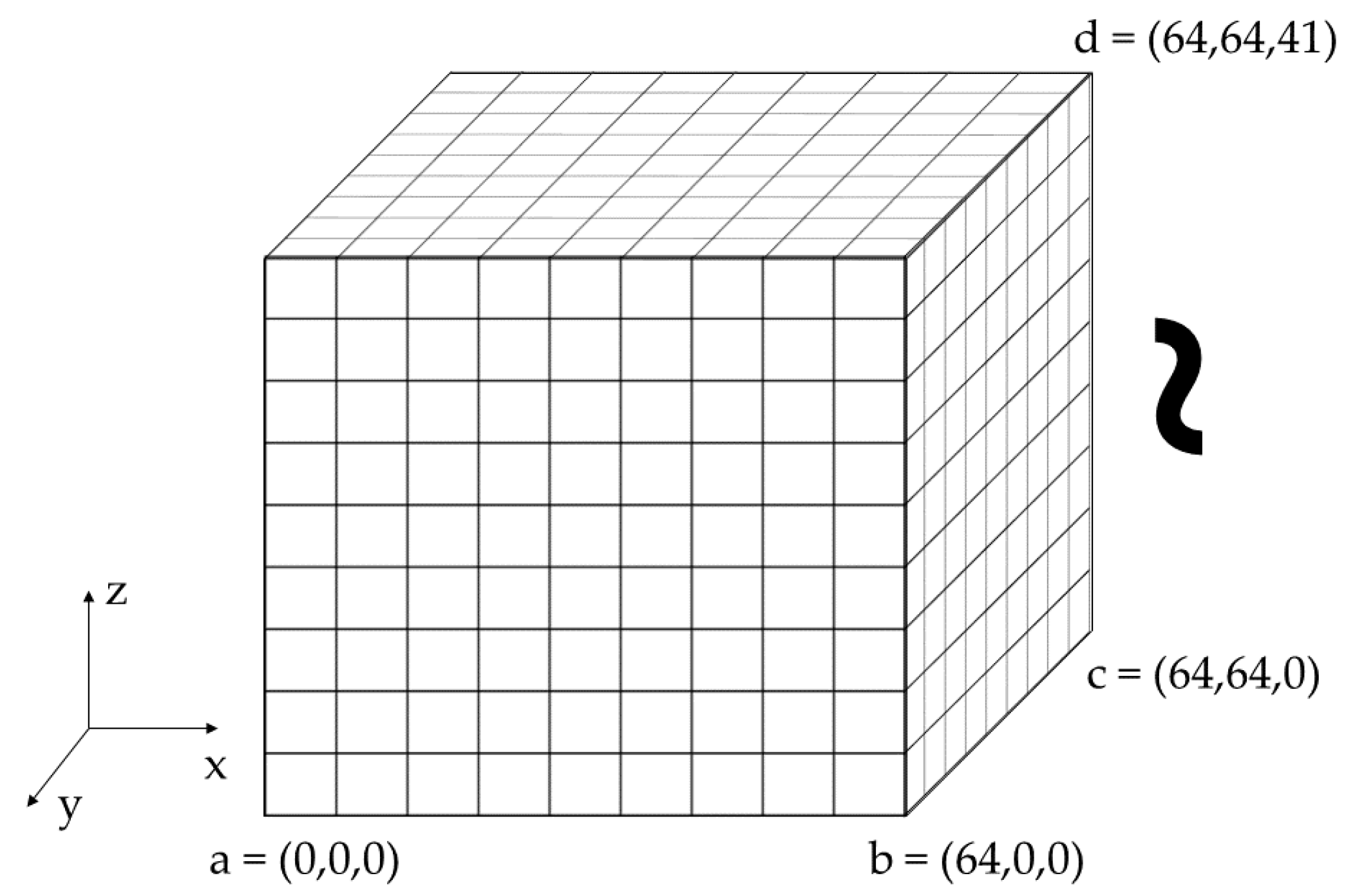

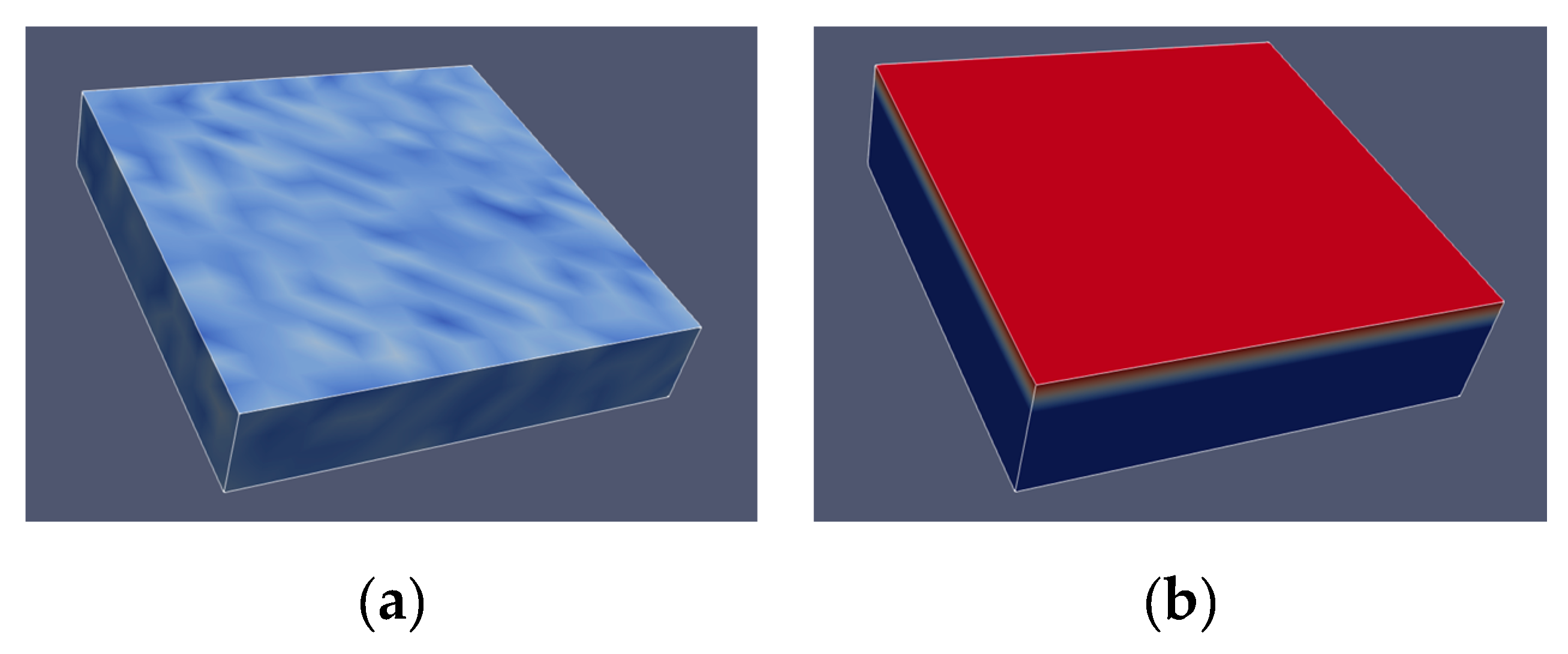
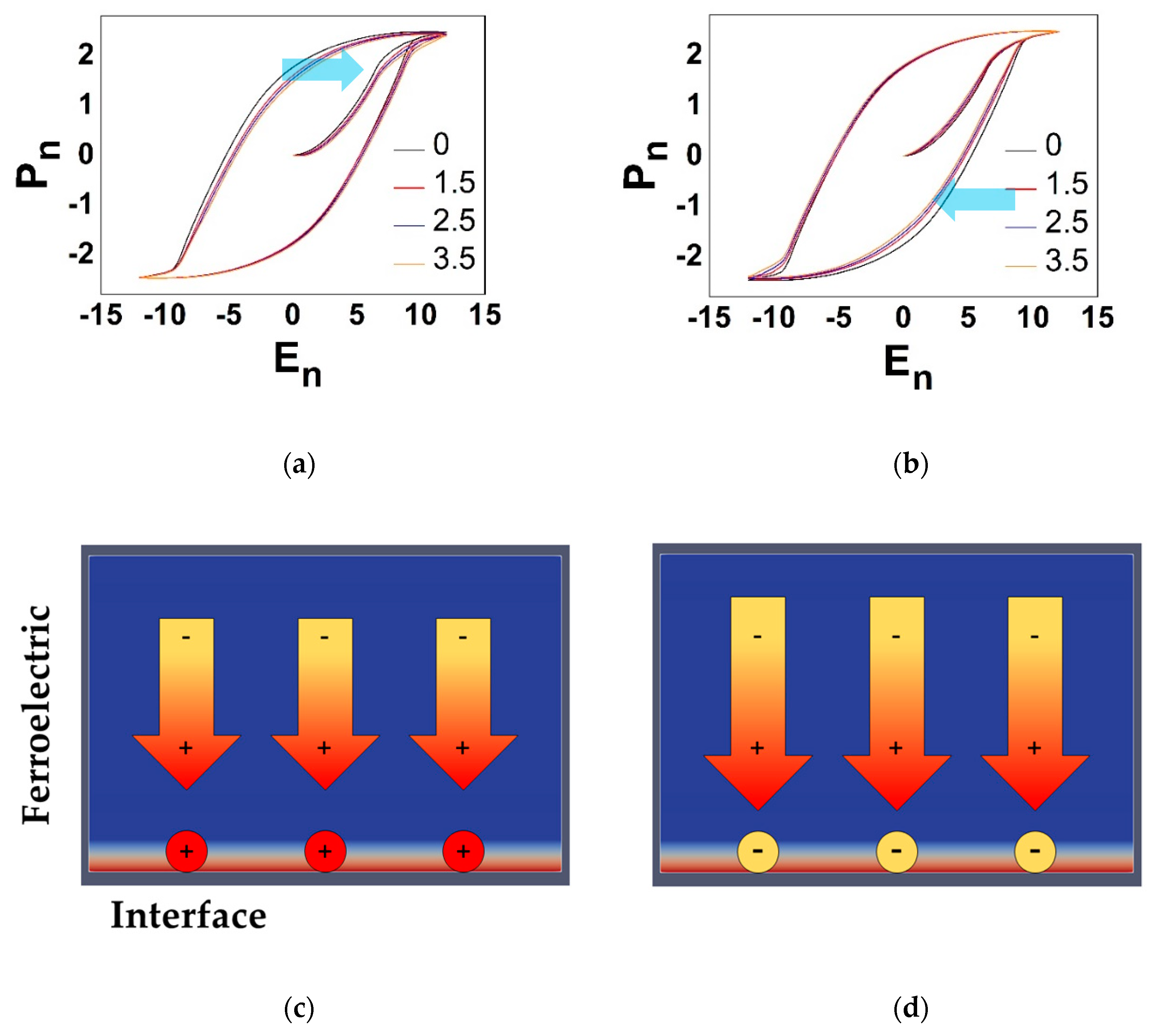
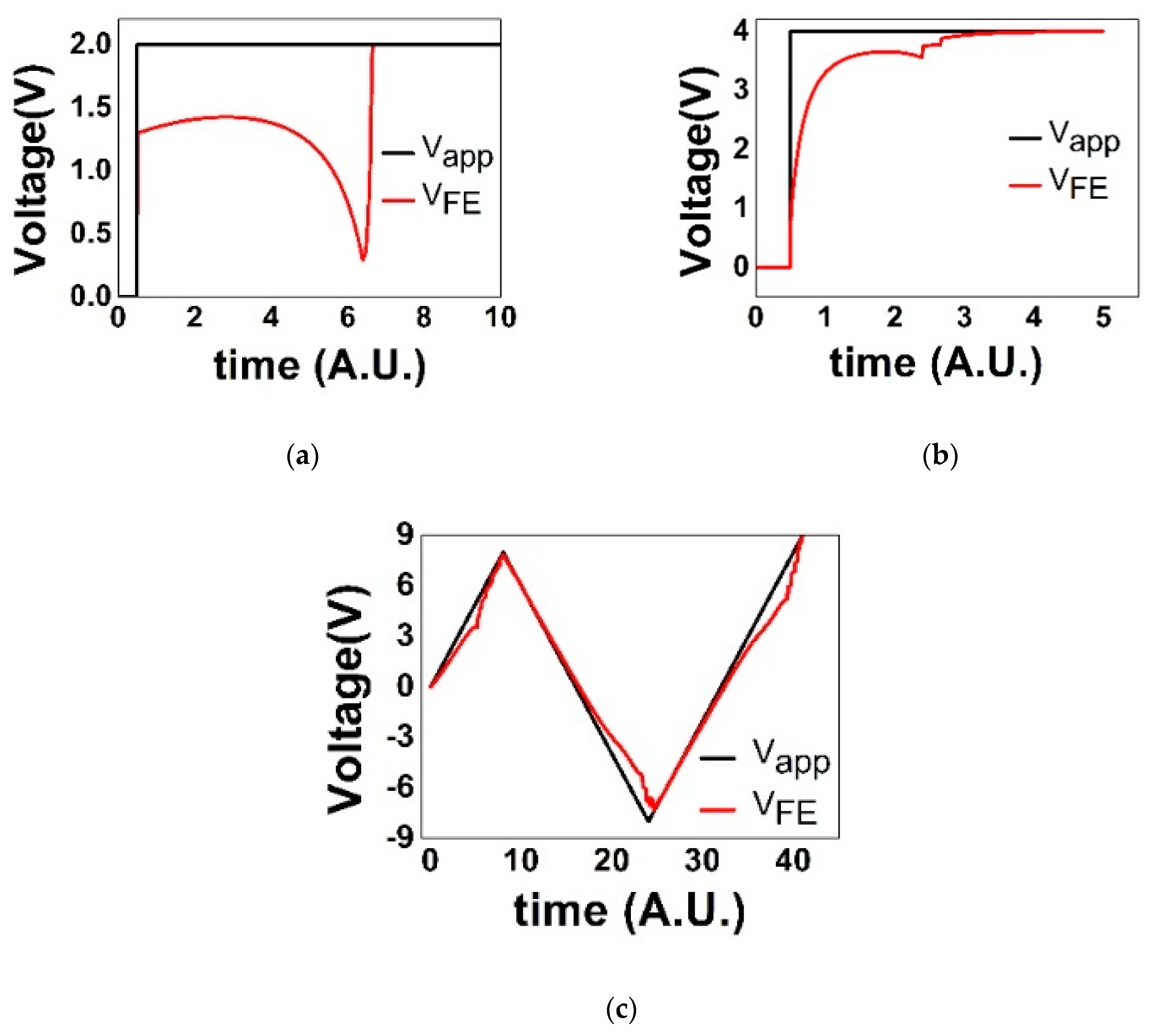
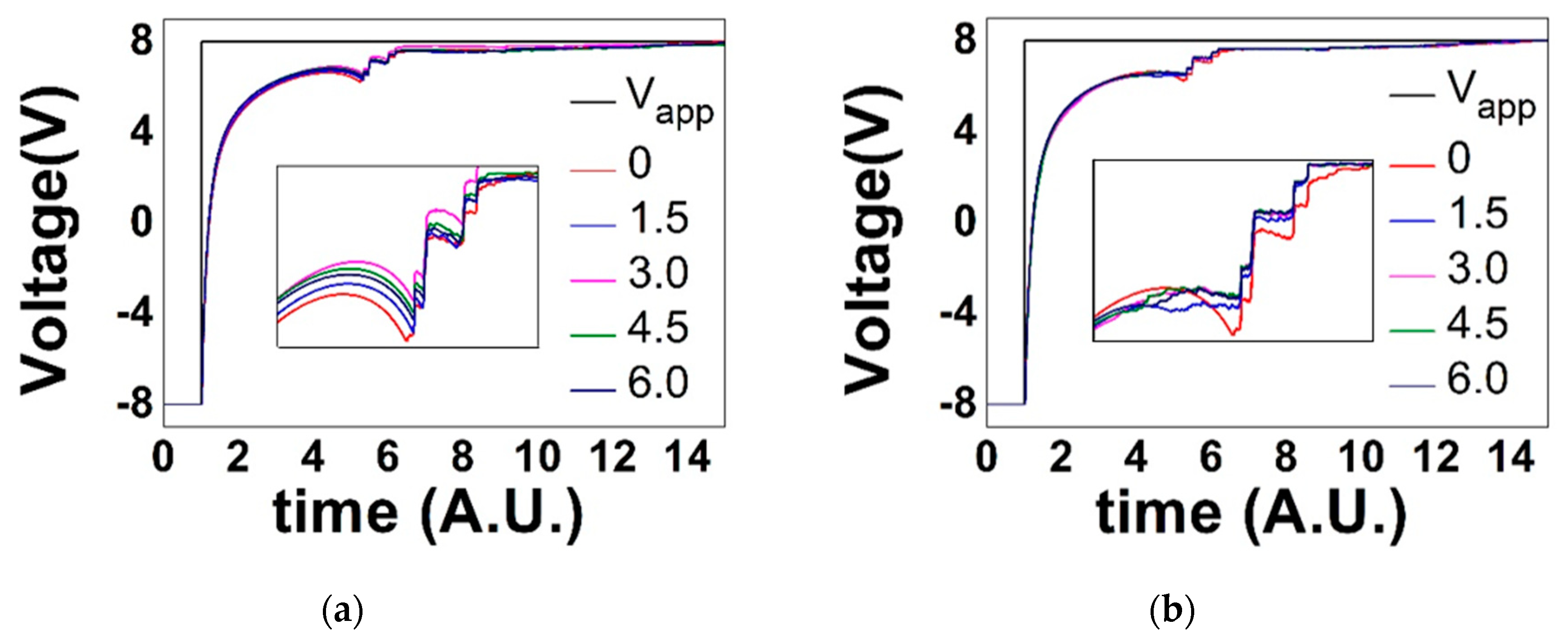
| Symbol | Quantity | Value |
|---|---|---|
| Landau expansion coefficient | −1.499 | |
| 0.498 | ||
| 0.001 | ||
| Domain coupling parameter | 1 | |
| 1 | ||
| L | Kinetic coefficient | 1 |
| A | Capacitor area [nm2] | 162 |
Publisher’s Note: MDPI stays neutral with regard to jurisdictional claims in published maps and institutional affiliations. |
© 2020 by the authors. Licensee MDPI, Basel, Switzerland. This article is an open access article distributed under the terms and conditions of the Creative Commons Attribution (CC BY) license (http://creativecommons.org/licenses/by/4.0/).
Share and Cite
Kim, T.; Shin, C. Effects of Interface Trap on Transient Negative Capacitance Effect: Phase Field Model. Electronics 2020, 9, 2141. https://doi.org/10.3390/electronics9122141
Kim T, Shin C. Effects of Interface Trap on Transient Negative Capacitance Effect: Phase Field Model. Electronics. 2020; 9(12):2141. https://doi.org/10.3390/electronics9122141
Chicago/Turabian StyleKim, Taegeon, and Changhwan Shin. 2020. "Effects of Interface Trap on Transient Negative Capacitance Effect: Phase Field Model" Electronics 9, no. 12: 2141. https://doi.org/10.3390/electronics9122141
APA StyleKim, T., & Shin, C. (2020). Effects of Interface Trap on Transient Negative Capacitance Effect: Phase Field Model. Electronics, 9(12), 2141. https://doi.org/10.3390/electronics9122141






